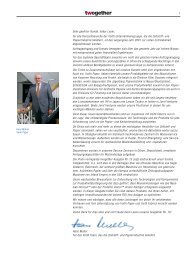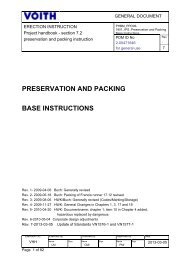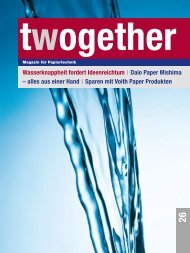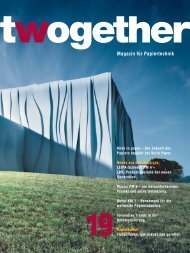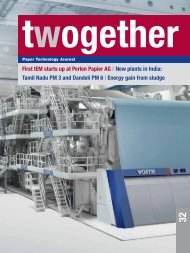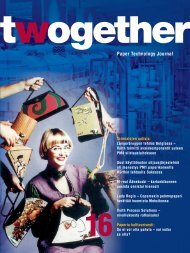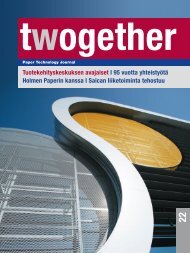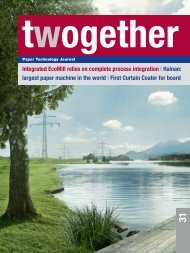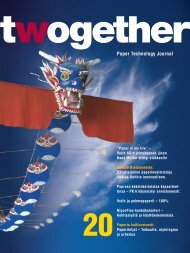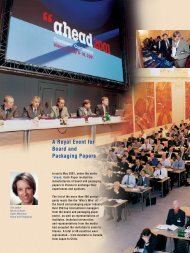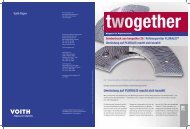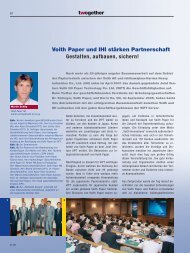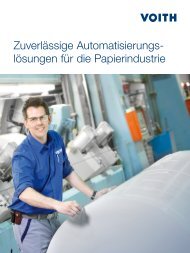You also want an ePaper? Increase the reach of your titles
YUMPU automatically turns print PDFs into web optimized ePapers that Google loves.
2<br />
40<br />
PM 6 – Excellent Performance<br />
from the Very Beginning<br />
In the mid-1990s, Kappa Zülpich took a<br />
decisive step to face the ever increasing<br />
international competition by investing<br />
in a new paper machine. <strong>Voith</strong> delivered<br />
the PM 6 with a wire width of 5,600 mm<br />
and a maximum production speed of<br />
1,000 m/min at that time.<br />
The machine concept comprises a horizontal<br />
DuoFormer CFD with a high<br />
drainage capacity, even at high basis<br />
weights and speeds. The press concept<br />
includes a tandem NipcoFlex press with a<br />
single-felted second nip. The dryer section<br />
was designed in close cooperation<br />
with the customer and has some special<br />
features, such as dryers with a diameter<br />
of 2.20 meters and a ropeless tail transfer<br />
system. At the time, Kappa Zülpich<br />
was the first customer to use this type of<br />
ropeless system for packaging papers<br />
with higher basis weights, which had<br />
been used exclusively for graphic papers<br />
<strong>17</strong>/04<br />
until then. A conventional size press is<br />
used for surface treatment. A fully automatic<br />
reel rounds off the well-tuned machine<br />
concept.<br />
The Long-Term Optimization<br />
of PM 6<br />
Together with <strong>Voith</strong>, the first strategic<br />
optimization measures were taken in the<br />
year 2000. Installing a double doctor at<br />
the first dryer and coating several dryers<br />
to prevent stickies or other sticky impurities<br />
from adhering to the surface were<br />
the first effective steps to be realized. In<br />
line with the long-term optimization concept,<br />
web stabilizers and ventilating doctors<br />
were installed in the after-dryer section<br />
in the following year, thus significantly<br />
improving both web run and CD<br />
moisture profile.<br />
Another measure was to upgrade tail<br />
transfer with optimized blow nozzle systems<br />
in the pre-dryer section.<br />
In September 2003, the most extensive<br />
rebuild so far was carried out, with the<br />
target to increase machine speed from<br />
the previous maximum of 1,050 m/min to<br />
1,200 m/min in the future, without impairing<br />
technological sheet properties.<br />
One of the key measures was to rebuild<br />
the DuoFormer CFD to improve drainage<br />
capacity and to adapt it to increased machine<br />
speeds. The existing forming roll,<br />
with a diameter of 1,260 mm, was replaced<br />
with a new vacuum-augmented<br />
forming roll with a diameter of 1,760 mm.<br />
Because of the new, much larger forming<br />
roll, the top wire suction box and its water<br />
discharge channels on drive side, as<br />
well as the bottom wire deflectors, were<br />
modified.<br />
In the press section, a new double doctor<br />
system was installed at the plain bottom<br />
roll of the second press nip which can be<br />
pivoted completely for maintenance purposes.<br />
Absolutely reliable doctoring is<br />
now guaranteed in this critical area where



